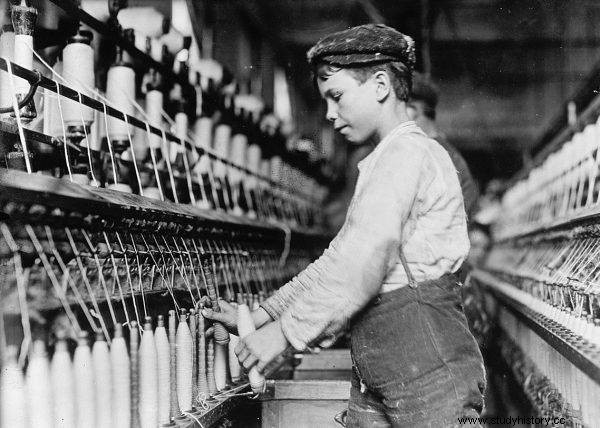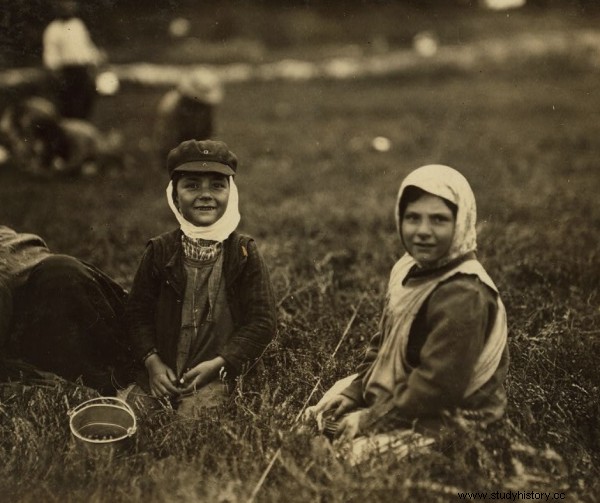The very description of the activities once entrusted to the youngest - in factories, mines and farms - is frightening. Meanwhile, in the 19th century, and even in the 20th century, hundreds of thousands of children joined the European working class. Was it really necessary to take away their "age of innocence"?
The power of industrial England was built by little hands that quickly changed spools of thread, cleared the bottlenecks of chimneys, dragged coal carts in the darkness of the mines. The eighteenth and nineteenth centuries are times of profound changes both for Great Britain and for the whole of Europe - the hatching of modernity. The profound transformation, symbolized by the industrial revolution, has affected all areas of life. Industrialization and urbanization brought about revolutionary changes in everyday life, ways of thinking, experiencing love and death, experiencing suffering and bliss.

Children could successfully perform repetitive and easy-to-learn activities. Photo from 1909, United States.
The 18th century brought great changes to the lives of the youngest and the poorest. How did the children become workers? The work of minors was not an invention of the industrial revolution. Before industrialization, they worked at home and farmyard, gained a profession in small factories or learning from their parents. Child labor became the norm only with the rapid development of industry, which needed cheap labor, and with the impoverishment of families who could not live off their parents' wages alone .
Excellent worker material
From the industrialist perspective, children, and especially orphans, were excellent material for workers. They were paid little or nothing. They had small working hands, they were in the tunnels and under the machines, they were fast and still healthy. They could be forced to obey by force of authority and force - they adapted to the factory regime sooner than adults because they knew no other life.
They could successfully perform repetitive and easy to learn activities. They were unable to rebel, and any attempt to resist could be broken with brute force . Besides, there was never a shortage of them and the kids, tired with exhausting work, were easily replaced with new ones.
Many contemporaries considered the work of the youngest to be a necessary condition for the development of the industrial revolution. Some saw nothing wrong with it - on the contrary, they considered it beneficial to the workers themselves. Andrew Ure, a chemist, doctor and one of the first business theorists, wrote about the children employed there:
They always seemed cheerful and alert, enjoying the light play of their muscles - enjoying the natural movement for their age. I was delighted to observe the agility with which the broken strands were tied and to see them resting after those few seconds of exercise for their little fingers. The work of these little elves resembles a sport whose repetition gives them dexterity that brings them pleasure .
The professor was so enchanted by his hardworking few-year-olds that he wrote the book The Philosophy of Manufaktur ( The Philosophy of Manufactures , 1835), in which he praised the existing factory system. Its aim was to persuade managers, directors and workers to follow a straight path of development and to discourage them from "dangerous" ideas. For example - improving the conditions or prohibiting the work of minors.
Childhood lost
During the Industrial Revolution, nearly 40% of Britain's eighteen million inhabitants were children under the age of fifteen. Over time, this percentage has increased even more. The childhood of those who were born in thatched huts and workers' cubicles was most strongly marked by dynamic industrialization and the related social changes.
Working-class children in the eighteenth and nineteenth centuries did a wide variety of jobs, some of which were extremely underestimated and escaped the public's attention, and consequently also legal regulations. This is especially true of the work of girls who worked as servants of wealthier families and performed similar duties in their own homes for free .

The youngest were often employed in the field during the season. Illustrative photo.
The children of the revolution are not only girls and boys working on looms in large factories. They are also those who have been forced by their parents' low wages or orphans to work in agriculture, in upper class homes, in small workshops and on the streets, selling matches, flowers or their own body. These are all the little ones to whom great changes have brought material and social poverty. Those that had been completely crammed into the industrial system and those that eluded him in various ways. Both those subordinated and enslaved, as well as those that rebelled, fought and protested. They are children who experienced the great transformations shaping modern Europe on their own skin.
They are not beautiful and innocent babies, imagined by the nineteenth-century romantic vision of childhood as the "age of innocence." We cannot call them either sweet angels or helpless victims. They are creatures of flesh and blood, trying to cope and seek happiness in the extremely difficult world they live in.
Source:The above text is an excerpt from Katarzyna Nowak's book Children of the industrial revolution , published by the Znak Horyzont publishing house.
